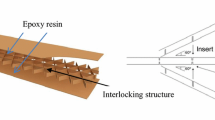Abstract
A fast simulation procedure for axially loaded ribbed composite structures is suggested based on the response surface methodology (RSM). The assessment of material degradation in terms of stiffness reduction in the skin-stringer zone is carried out to ensure the design reliability, thus acquiring a fast simulation procedure for an efficient and reliable analysis of the behaviour of axially loaded ribbed composite panels in their postbuckling state.
Similar content being viewed by others
References
R. Degenhard, R. Rolfes, R. Zimmerman, and K. Rohwer, “COCOMAT —improved material exploitation of composite airframe structures by accurate simulation of postbuckling and collapse,” Compos. Struct., 73, 175–178 (2006).
A. Kling, R. Degenhard, and R. Zimmerman, “A hybrid subspace analysis procedure for non-linear postbuckling calculation,” Compos. Struct., 73, 162–170 (2006).
De Xie and S. Biggers Jr., “Postbuckling analysis with progressive damage modelling in tailored laminated plates and shells with cutout,” Compos. Struct., 59, 199–216 (2003).
R. M. Myers and D. C. Montgomery, Response Surface Methodology, 2nd Ed., John Wiley & Sons, New York (2002).
R. Rikards, H. Abramovich, J. Auzins, A. Korjakins, O. Ozolinsh, K. Kalnins, and T. Green, “ Surrogate models for optimum design of stiffened composite shells,” Compos. Struct., 63, 243–251 (2004).
R. Rikards, H. Abramovich, K. Kalnins, and J. Auzins, “Surrogate modeling in design optimization of stiffened composite shells,” Compos. Struct., 73, 244–251(2006).
H. Abramovich, A. Grunwald, P. Pevsner, T. Weller, A. David, G. Ghilai, A. Green, and N. Pekker, “ Experiments on axial compression postbuckling behavior of stiffened cylindrical composite panels,” in: Proc. of 44th AIAA/ASME/ASCE/AHS, Structures, Structural Dynamics and Material Conference, AIAA Pa per No. 2003-1793, Norfolk (2003).
A. C. Orifici, R. S. Thomson, A. J. Gunnion, R. Degenhardt, H. Abramovich, and J. Bayandor, “Bench mark finite element simulations of postbuckling composite stiffened panels,” in: Proc. of 11th Australian Aerospace Int. Congress, 13–17 March, Melbourne (2005).
C. Bisagni, P. Cordiso, H. Abramovich, and P. Pevsner, “Buckling and postbuckling behaviour of stringer stiffened laminated composite curved panels subjected to shear,” in: Advances in Composites & Experimental Engineering. & Science, Tech. Science Press, Forsyth (2004), pp. 339–344.
H. Abramovich, T. Weller, and R. Yaffe, “Application of a modified Donnell technique for the determination of critical loads of imperfect plates,” Comput. Struct., 37, 463–469 (1990).
J. Singer, J. Arbocz, and T. Weller, Buckling Experiments: Experimental Methods in Buckling of Thin-Walled Structures. Vol. 2, John Wiley & Sons, New York (2002).
L. H. Donnel, “On the application of Southwell’s method for the analysis of buckling tests,” in: Timoshenko 60th Anniversary Volume, McGraw-Hill, New York (1938), pp. 27–38.
H. Abramovich and T. Weller, Buckling until Collapse of a Damaged Panel, COOCMAT —Technion Technical Report, January 7, Tel Aviv (2005).
A. Korjakins, P. Kara, and K. Kalnins, “Buckling and postbuckling analyses of stiffened composite shells with inter-laminar damages,” in: Proc. of 5th European LS-DYNA Users Conf., 25–26 May, Birmingham, No. 5d-28 (2005).
K. T. Fang and Y. Wang, Number-Theoretic Methods in Statistics, Chapman & Hall, London (1994).
R. Jin, W. Chen, and T. Simpson, “Comparative studies of metamodeling techniques under multiple modeling criteria,” Struct. Optimiz., 23, No. 1 (2001).
J. Auzins, “Direct optimization of experimental designs,” in: Proc. of 10th AIAA/ISSMO Multidisciplinary Analysis and Optimization Conf., AIAA Paper No. 2004-4578, Albany (2004).
A. Janushevskis, T. Akinfiev, J. Auzins, and A. Boyko, “A comparative analysis of global search procedures,” in: Proc. of the Estonian Academy of Sciences, 10, No. 4, 236–250 (2004).
J. Auzins, K. Kalnins, and R. Rikards, “Sequential design of experiments for metamodeling and optimisation,” in: Proc. of 6th World Congress of Structural and Multidisciplinary Optimization, 30 May-3 June, Rio de Janeiro (2005).
Author information
Authors and Affiliations
Additional information
Russian translation published in Mekhanika Kompozitnykh Materialov, Vol. 43, No. 3, pp. 339–348, May–June, 2007.
Rights and permissions
About this article
Cite this article
Kalnins, K., Auzins, J. & Rikards, R. A fast simulation procedure for ribbed composite structures with material degradation. Mech Compos Mater 43, 225–232 (2007). https://doi.org/10.1007/s11029-007-0022-2
Received:
Issue Date:
DOI: https://doi.org/10.1007/s11029-007-0022-2




